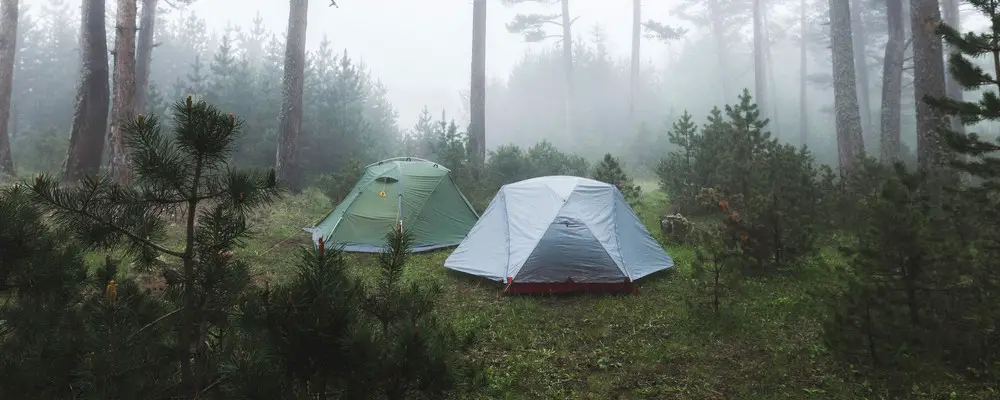
A wet down sleeping bag is every camper’s nightmare. At best, it means you’re in for an uncomfortably clammy night — and in colder conditions it can even put you at risk of hypothermia.
Of course, prevention is better than a cure — which is why you should keep your sleeping gear in a dry-bag — but hindsight is always 20/20 and accidents happen.
So what to do if your down sleeping bag gets wet? Here’s some ideas for when you’re facing a long, cold evening in a soggy down sleeping bag…
- Down sleeping bags are especially vulnerable to water. They lose most of their warmth and take a very long time to dry.
- The first step is to assess both the condition of the sleeping bag and your wider situation.
- The best option may well be to bail out and get to shelter. Live to fight another day.
- If you’re camping with other people, you might be able to share sleeping bags, body heat, and other insulation.
- Solo campers will need to go into survival mode. Improvise insulation, eat well, use hot water bottles, and even make a campfire if necessary.
- Once you’ve made it through the night, you can come up with a new plan to get your sleeping bag dried out.
Why Is It Such a Problem if Your Down Bag Gets Wet?
Your down sleeping bag is so warm because when you pull it out of its compression sack and lay it out for the night, the super-fine down filaments “loft up” — curling and expanding to fill the shell of the sleeping bag.
These down fibers trap tiny pockets of warm air, and it’s this that keeps you so toasty in the night.
But, if down gets wet, it sticks together and won’t loft up. It takes on the consistency of soggy newsprint, and nature’s miracle insulator becomes next to useless.
It’s worth mentioning that several manufacturers now use hydrophobic shell materials and treat their down to give it a degree of water-resistance. These bags still won’t survive a soaking, but they’re streets ahead of a standard down bag. There’s more information on this in our guide to choosing a down sleeping bag.
Likewise, synthetic bags fare better when they get wet. But that’s not much consolation when you haven’t got one with you.
Can You Dry a Down Sleeping Bag in the Wild?
When wondering what to do if your down sleeping bag gets wet, the first question is “How wet?”.
If your bag is only damp — or has just gotten wet in one or two spots — you may well be able to dry it in the night using your body heat. But anything worse than that and you will struggle.
You see, another drawback of down sleeping bags is that they take a very long time to dry. Consider that when you wash one, it can take up to five hours in a commercial dryer to get it dried out — so hanging it in a tree for half an hour as the sun’s going down is not going to cut it.
Some online sources recommend drying a wet bag over a campfire, but this is going to take an incredibly long time — and we’d also suggest that the only thing less useful than a wet sleeping bag is one you’ve set on fire.
A potential exception to this is if you have a large “hot tent” with a wood-burning stove in it. If you’re able to hang the sleeping bag well clear of the fire and keep the stove going for several hours (remembering all the safety tips in this article, of course), then you might be in with a chance.
Generally, though, it’s difficult to get a wet sleeping bag dry while outdoors.
So what do you do when the worst happens and you unpack your down sleeping bag to discover it’s waterlogged?
Assess the Situation
A wet down sleeping bag isn’t always a problem, but sometimes it really is. The key is being able to weigh up your individual circumstances and make the right judgment call.
Assess the Bag Itself
The first thing to ascertain is how wet your sleeping bag actually is.
If it’s just damp then you’ll probably be alright. You might need to wear some extra layers at night, but your body heat should help dry it out — and you may even be able to air it out in the sunshine if you’ve still got some daylight left.
Often, only a couple of spots will be wet, perhaps where rainwater has pooled in the bottom of your pack or where you’ve accidentally knocked a leaky water bottle over in your tent. In these cases you can probably squeeze the excess water out and protect yourself from the wet bit with a folded fleece or jacket.
It’s rare that a sleeping bag gets completely soaked, but it does happen. This is more serious, since your bag isn’t going to do its job until you can get it dry.
Assess the Broader Situation
Clearly, the scale of your problem will depend on other factors too. Questions to ask yourself include:
- How cold is it? And how cold will it get during the night?
- How far are you from help or shelter?
- What sort of physical and mental shape are you in?
If the temperature is likely to drop below freezing in the night and you’re dead beat after a long day’s hiking, you’re in danger of hypothermia without a functional sleeping bag.
Remember that we can also struggle to make good decisions when we’re tired and cold — and it can feel much harder to take action compared to doing nothing.
If your wet sleeping bag is the result of an accident (for example, a canoe capsize), then this can also knock your confidence and make you question your own judgment.
However, being conscious of your circumstances — and the factors that might be affecting your decision-making — can help you make better choices.
Consider Bailing Out
Seriously. If your down sleeping bag is soaked, it will be of very little use — and in colder climates there could be a real danger to your life.
Think about how far you are from safety. Are there any settlements within reach where you could find accommodation? Failing that, are there any other forms of shelter like cabins or mountain refuges?
If nothing else, it’s a good idea to get below the treeline. You’ll be less vulnerable to weather and wind-chill, and you’ll also have firewood if you need it.
Sometimes the walk-out might seem like a lot of effort, but remember that movement will help keep you warm. It’s also better to make these decisions earlier, rather than deciding to saddle up when it’s dark and you’ve already spent three hours shivering in your tent.
If you consider you’re in genuine danger, it’s time to contact the emergency services. It’s a hard call, but mountain and wilderness rescuers don’t play the blame game and they would always rather recover you alive.
Bailing can feel a little like defeat, but it absolutely isn’t. Things go wrong in the outdoors all the time, and the mark of a great outdoorsman or woman is how they adapt to fast-moving situations.
The mountains will be there another day — so you need to make sure you are too.
Pool Your Resources
If you’re camping with another person and you’ve got at least one dry sleeping bag between you, then you might be able to muster up enough heat to stay warm through the night.
Dress warmly, share body heat, insulate underneath yourselves, and open the sleeping bag out to make a quilt that you can share. Don’t forget to use your Mylar emergency space blankets if you have them — and you can also put your feet in your rucksacks to try and keep the cold out of your toes.
Activate Survival Mode
If you’re on your own and there’s no shelter nearby, you’ll need to get creative:
- Wear all the clothes you can (puffy jackets and pants are great if you have them)
- Put your feet in your rucksack
- Insulate yourself from the ground as best you can
- Wrap yourself in anything that’s available — including tarps or emergency blankets
- Have plenty of warm food and drink before you go to bed
- Make yourself a hot water bottle.
Depending on how wet your sleeping bag is, some people in outdoor forums have reported staying moderately warm (if not exactly comfortable) by wearing full waterproofs inside their damp bag.
If you find yourself getting really cold in the night, come up with a new plan rather than just lying there. Make yourself a warm drink, refill your hot water bottle, or even build a fire if you have to.
Obviously it’s anti-social, hazardous, or even illegal to light fires in certain areas, but in a genuine emergency you need to weigh up the risks and make that call. If you do think you’re going to have to make a fire, it’s best to gather fuel and split out dry kindling before you lose the light, just in case.
Next Steps
So you’ve made it through the night. What next?
Well, broadly you rinse and repeat the steps above. Assess your situation and consider your options. If you’re somewhere really warm, you might be able to dry your sleeping bag — but otherwise it’s going to be difficult to achieve this in the field and you’re probably looking at a walk-out.
Morning might bring new realities. The weather may have changed for better or worse, and depending on the night you’ve had, you too may be feeling fresher or more exhausted.
Crucially, you’ll have a full day ahead of you — which gives you a much better chance of finding shelter, warmth, and a way to get your sleeping bag dry.
However you resolve your predicament, once you’ve finished looking after yourself it’s time to look after the sleeping bag. Avoid mildew and mold by drying it out fully as soon as you can, and follow our storage tips to make sure it lasts you for many more adventures.
FAQs
What Happens if Your Down Sleeping Bag Gets Wet?
A wet down sleeping bag will provide very little warmth and is difficult to get dry. Your best option is usually to find alternative sleeping arrangements for the night if you can.
How Do You Dry a Wet Down Sleeping Bag?
You can dry a damp bag using your body heat, but it’s very difficult to get a really wet sleeping bag dried out in the wild.
Are Down Sleeping Bags Waterproof?
Down sleeping bags aren’t usually waterproof, but some down is treated to give it a moderate amount of water-resistance.






